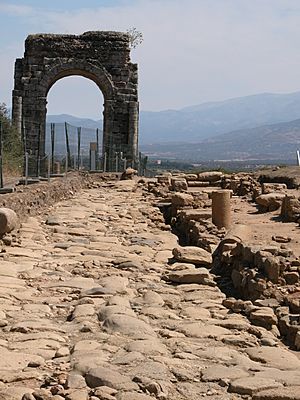Cáparra facts for kids
|
Municipium Flavium Caparensis
|
|

View of the quadrifrons gate which was the entrance to Capara's forum
|
|
| Location | near Guijo de Granadilla and Oliva de Plasencia (Spain) |
|---|---|
| Type | Ciudad |
| History | |
| Founded | 1st century. Municipium from 74. |
| Abandoned | 9th century |
| Periods | Roman empire |
| Associated with | Initially Vettones; from 74 Latin and Roman citizens. |
| Site notes | |
| Bien de interés cultural RI-55-0000016 catalogued as an Archaeological Zone and protected since 3 June 1931 | |
The Roman city of Cáparra is an ancient city located in the north of Extremadura, Spain. It sits in the beautiful valley of the River Alagón.
During the time of the Roman Empire, Cáparra was part of a large Roman province called Lusitania. It was connected to other important cities by a famous Roman road known as the Vía de la Plata. Today, Cáparra is no longer inhabited and stands as an archaeological site.
Contents
What Was Cáparra Like?
Cáparra was a walled city that covered about 15 to 16 hectares. That's roughly the size of 20 to 22 football fields! However, many houses were built outside the walls, so the actual city was much bigger.
Even though it was smaller than some other Roman cities in the Iberian Peninsula, Cáparra was still an important place. It was one of the main towns between the Tagus river and the Sierra de Gredos mountains. Other important towns nearby included Caurium (modern-day Coria) and Augustobriga (now Talavera la Vieja).
City Layout and Design
The city of Cáparra was designed in a very organized way, like a grid. The Vía de la Plata, the main Roman road, ran right through the city from north to south. This road acted as the city's central street.
The Name of Cáparra
The name "Cáparra" isn't originally Latin. It likely came from the Vettones, a group of people who lived in this area before the Romans arrived. The name has been spelled in different ways over time, like Capara, Capera, and Kapasa.
Historians believe the name might mean a place for trading or exchanging goods. This makes sense because Cáparra was located where two important roads met. One road led to El Jerte through the Puerto de San Gamello, and the other connected to Roman bridges over the Ambroz and Alagón rivers. This made Cáparra a busy hub for travelers and traders.
History of Cáparra
Cáparra became a Roman city in the 1st century AD. In the year 74 AD, it was given the special status of a Municipium. This meant its citizens had many of the same rights as Roman citizens.
The city was abandoned around the 9th century. Today, it is a protected archaeological zone. It has been recognized as a Bien de interés cultural (a site of cultural interest) since June 3, 1931. This means it's a very important historical place that needs to be preserved.
See also
 In Spanish: Cáparra para niños
In Spanish: Cáparra para niños

